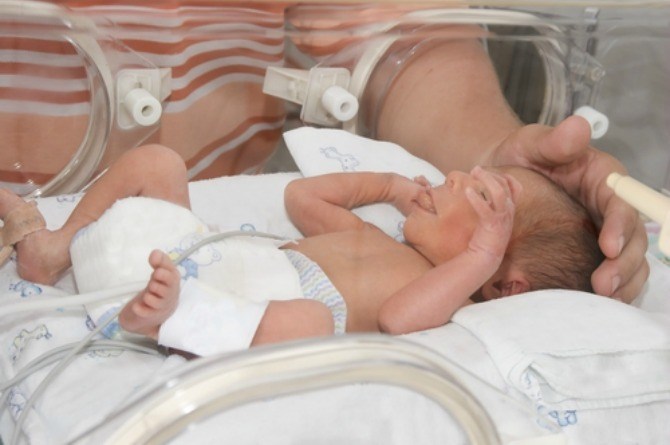Soon after your toddler is born, his well being can be monitored fairly intently by medical doctors and nurses on the hospital. One pretty frequent situation they give the impression of being out for is jaundice.
Jaundice is sort of regular in most newborns (occurring 2-Three days after beginning), and provided that it goes above the ‘regular’ vary will medical employees intervene.
This situation is extra frequent amongst infants who’re breastfed, and lasts a bit longer too amongst them too, say medical specialists.
In this text, we speak concerning the relationship between new child jaundice and breastfeeding, methods to deal with it and extra.

Newborn jaundice is sort of frequent
What is new child jaundice?
Jaundice is a yellowing of the pores and skin and/or whites of the eyes, that’s brought on by larger bilirubin ranges in a new child’s blood.
It is most blatant once you flippantly press on a new child’s pores and skin to empty away the pink color, and once you carry your finger, the yellowish tinge of the pores and skin turns into clear.
Bilirubin is a yellowish substance the physique produces when it replaces previous pink blood cells.
When your child continues to be in your womb, your placenta removes bilirubin out of your toddler’s physique. However, after beginning, your child’s liver takes over doing this job — and it might take a while for it to do that correctly.
Because of this, it’s fairly regular for a child’s bilirubin degree to be a bit excessive after beginning, and it’s this that causes jaundice. Once your toddler is a bit larger and the pink blood cell quantities diminish, with this, the jaundice often subsides too, usually 1-2 weeks after beginning.
Usually, jaundice seems first on a new child’s face, transferring down the physique to the chest, tummy, legs and arms. This situation may be more durable to detect in darker-skinned infants, and is finest seen in pure mild.
If your physician suspects your toddler has jaundice, then he/she’s going to examine your child’s bilirubin ranges by means of a blood take a look at, and suggest the very best plan of action accordingly.
What causes jaundice?
SingHealth presents the next causes of jaundice:
- Some infants develop jaundice due to the breakdown of blood attributable to bruising throughout beginning, or superficial blood clots on their head.
- When a child’s blood group is totally different to his mom’s, the mom’s antibodies might assault the child’s pink blood cells, leading to jaundice.
- Some infants have an inherited glucose-6-phosphate dehydrogenase (G6PD) deficiency that causes jaundice. G6PD is an enzyme within the physique that helps pink blood cells operate usually.
- Occasionally, little ones develop jaundice due to an an infection of the urinary system or blood.
- Jaundice lasting for greater than two weeks may very well be attributable to an an infection, irregular bile ducts or a metabolic illness.
- Prematurity (infants born between 34 to 36 weeks) may cause jaundice attributable to these infants’ much less mature liver.
Do remember the fact that in lots of infants, the underlying trigger for jaundice won’t be discovered.

Breastfed infants have a barely larger tendency to develop jaundice – however that is no cause to discontinue breastfeeding.
Types of jaundice
1. Physiologic Jaundice
This is the commonest kind of jaundice amongst newborns, affecting as much as 60% of full-term infants of their first week of life, says the American Pregnancy Association (APA).
It is brought on by elevated bilirubin ranges, as defined earlier on this article.
2. Breastmilk jaundice
This is jaundice that lasts after physiologic jaundice subsides, and is seen in full-term, breastfed infants. According to the National University Children’s Medical Institute (Singapore), this sort of jaundice sometimes happens at four to 7 days of age and should final from Three to 10 weeks.
While medical specialists say there isn’t any recognized trigger for breastmilk jaundice, there are theories that it is perhaps linked to a part of breastmilk that blocks the breakdown of bilirubin. This form of jaundice tends to run in households.
Most newborns who’ve true breast milk jaundice (solely zero.5% to 2.four% of all newborns) may expertise one other improve of their degree of bilirubin at about day 14; nonetheless, these ranges will step by step decline.
If your child has breastmilk jaundice, please don’t assume one thing is improper along with your milk and cease breastfeeding due to this. As lengthy as your toddler is nursing nicely and his bilirubin ranges are monitored, critical problems are uncommon.
In the phrases of internationally famend paediatrician and lactation skilled Dr. Jack Newman, “Do not cease breastfeeding for breastmilk jaundice.”

Continuing to nurse your breastfed child with jaundice will assist cut back bilirubin ranges.
Three. Breastfeeding jaundice (not-enough-breastmilk jaundice)
High ranges of bilirubin or jaundice that linger on for longer than ordinary might happen when a child shouldn’t be getting sufficient breastmilk.
When a child will get inadequate breastmilk, his bowel actions are much less, inflicting the bilirubin that was within the intestine to get reabsorbed into the bloodstream as an alternative of leaving the physique with the bowel motion, explains Dr. Newman.
This causes breastfeeding jaundice — that is not associated to breastmilk jaundice.
The causes for this sort of jaundice to emerge are attributable to one or a mixture of the next:
- an improper latch
- the mom’s milk taking longer than ordinary to “come in”
- when the child is given different substitues that intervene with breastfeeding
- limitation of breastfeeding attributable to hospital routines
Quite clearly, the easiest way to keep away from breastfeeding jaundice is to get breastfeeding established nicely, and early. If a child has this sort of jaundice, elevated feedings and assist from a lactation advisor to make sure child is taking in sufficient milk will assist resolve the situation rapidly.
On the following web page: what do you have to do in case your child has breastmilk jaundice or breastfeeding jaundice? We additionally inform you concerning the remedy choices for jaundice.
Pages: 1 2
















You must be logged in to post a comment Login